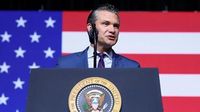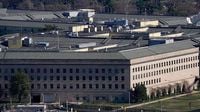On September 30, 2025, the usually reserved halls of Marine Corps Base Quantico in Virginia were charged with a rare, almost theatrical energy. Top U.S. military commanders, joined by their counterparts from around the globe, gathered for what would turn out to be a dramatic and controversial address by President Donald Trump and his newly appointed Secretary of Defense, Pete Hegseth. The event, which was broadcast live and quickly made headlines, marked a decisive—and for many, unsettling—shift in the direction of American military policy.
President Trump set the tone early, directing military leaders to refocus their efforts on what he described as “the enemy within.” He suggested that deploying troops to American cities would not only strengthen national security but also serve as valuable training for soldiers. According to The American Prospect, Trump told the assembled generals and admirals that urban deployment would prepare them for the kinds of threats now facing the country from within its own borders. In a particularly pointed moment, he remarked, “I told Pete we should use some of these dangerous cities as training grounds for our military—National Guard, but military—because we’re going into Chicago very soon.”
Yet, it was Secretary Hegseth’s follow-up address that truly crystallized the administration’s new vision for the military. In a speech that blended populist bravado with a hardline stance on discipline and culture, Hegseth called for the elimination of what he termed “politically correct and overbearing rules of engagement.” Instead, he advocated for a return to what he saw as the core mission of the armed forces: winning wars through a warfighting ethos, unencumbered by what he dismissed as “woke” leadership and social justice initiatives. “We untie the hands of our war fighters to intimidate, demoralize, hunt, and kill the enemies of our country. No more politically correct and overbearing rules of engagement,” Hegseth declared, as reported by The American Prospect.
Hegseth’s directives were sweeping. He announced that the Department of Defense—now referred to by the administration as the Department of War—would drop restrictions on bullying and hazing, claiming this would empower leaders to enforce standards without fear of retribution. “No more walking on eggshells,” he told the assembled officers. Those unwilling to comply with the new regime, he warned, should “do the honorable thing and resign.”
One of the most controversial aspects of Hegseth’s speech was his insistence on strict physical fitness standards for all military personnel, regardless of rank or role. “It’s completely unacceptable to see fat generals and admirals in the halls of the Pentagon,” he said, adding that all personnel must pass physical training tests and meet weight requirements twice a year. “Whether you’re an airborne Ranger or a chairborne Ranger, a brand-new private or a four-star general, you need to meet the height and weight standards and pass your PT test.” Hegseth’s demand for daily, rigorous workouts—“We’re not talking, like, hot yoga and stretching. Real hard PT.”—was a dramatic departure from previous norms, where senior officers in desk-bound commands often received waivers or relaxed standards.
The reaction from within the military community was mixed. Garrett Smith, an active-duty Marine Corps reservist and CEO of defense tech firm Reveal, told Military Times that while the spectacle was unusual, it was not entirely without precedent. “At a first level, at any big multinational corporation or big organization, when there’s a new boss, it’s totally reasonable to call in all your regional managers and VPs for a setting of tone, to reconfirm the agenda, to ensure alignment. So, all of that makes sense,” Smith said. “But, obviously, these are not normal times. This is the Trump administration. So, it’s going to come with a bunch of enhanced drama and mystique and weirdness about it.”
Others saw the move as a clear warning to military leadership. “It was crystal clear. Generals and admirals are on notice. Comply and enforce these new policies and culture or be fired. No more woke leaders,” said Amber Smith, a combat veteran and advisor with the Coalition for Military Excellence. Chad Robicheaux, a former reconnaissance Marine, described the event as a “historic come-to-Jesus meeting,” emphasizing that the days of resistance and divisiveness were, in the administration’s view, over.
Hegseth’s push for uniformity extended beyond physical fitness. In a move that has already sparked heated debate, he vowed to purge the military’s “beardos” by enforcing strict grooming rules. “If you want a beard, you can join special forces. If not, then shave. We don’t have a military full of Nordic pagans,” Hegseth said, according to Axios. He further declared, “The era of rampant and ridiculous shaving profiles is done. If you don’t meet the male-level physical standards for combat positions, cannot pass a PT test or don’t want to shave and look professional, it’s time for a new position.”
This policy has raised serious concerns among religious groups and advocates for service members with medical conditions. For Sikhs, Muslims, and some Jewish troops, uncut beards are not just a matter of personal style but a central tenet of their faith. Marissa Rossetti, senior staff attorney at the Sikh Coalition, told Axios, “We have Sikh service members who are deployed with beards right now—it’s not a hindrance to how they’re serving this country.” She warned that the new policy could force individuals to choose between their religious beliefs and their military careers. The Council on American-Islamic Relations echoed this concern, sending a letter to Hegseth emphasizing that religious freedom “is a constitutional right, even in uniform.”
Medical experts have also flagged the potential impact on personnel with skin conditions aggravated by shaving, such as pseudofolliculitis barbae—a condition affecting up to 60% of African American men and others with curly hair, according to the American Osteopathic College of Dermatology. NAACP President Derrick Johnson criticized the new rules as “a broader assault on Black identity despite its guise of ‘uniformity.’”
The administration’s approach, critics argue, amounts to a rejection of the diversity and division of labor that have long been hallmarks of the U.S. military. As The American Prospect pointed out, historically important noncombat roles—from code-breakers like Alan Turing to generals like Henry Knox—would not have met Hegseth’s standards. And as warfare becomes increasingly reliant on technology, intelligence, and cyber operations, the insistence on universal combat fitness and grooming threatens to sideline those whose skills are critical to modern defense.
Supporters of the new policies, however, see them as a necessary correction after years of what they view as mission drift. “If we want to present a deterring force to the world so we don’t have to go to war, we have to be ready to win the next war. That is the deterrent force we project,” said Smith, the Marine Corps reservist. He and others argue that a renewed focus on warfighting and readiness will strengthen the military’s core mission.
As the dust settles from this unprecedented meeting, it is clear that the Trump administration’s directives have already set in motion a profound transformation of the U.S. military’s culture and priorities. Whether these changes will deliver the promised results—or provoke further division and legal challenges—remains to be seen. For now, the nation’s armed forces, and the country they serve, are bracing for a new era marked by uncompromising standards, heightened rhetoric, and a reassertion of presidential authority.


